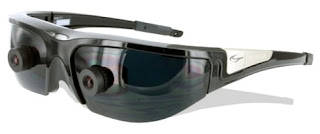Luke Roberts - http://lroberts-tamuchi.blogspot.com/2011/01/reading-41-liquidtext-active-reading.html
Pape Youm - http://436chi-lounge.blogspot.com/2011/01/paper-reading-57-rolling-and-shooting.html
Reference Information
Title: Rolling and Shooting: Two Augmented Reality Games
Authors: Ohan Oda, Steven Feiner
Presentation Venue: CHI 2010: 28th ACM Conference on Human Factors in Computing Systems; April 10-15, 2010; Atlanta, GA, USA
Summary
The paper presents two different augmented reality games in which different tools are used to combine game elements with the real world.
The first game discussed is a single-player game in which the player wears a head-worn display that tracks optical patterns on a game board. The goal of the game is to steer a virtual marble through a maze on the game board by tilting and moving the board. The game makes use of real-world gravity to determine which way is down.
The second game discussed is a two-player first-person-shooter in which the players look at a game board marked with optical markers through their own ultramobile personal computer (UMPC). Each player tries to knock down the opposing player’s virtual dominoes by tapping the screen of their UMPC. By doing as such, they fire virtual balls. They used redirected motion, a technique that transforms the 3D space, to prevent the players from interfering with each other during game play.
Discussion
The authors concisely present two different augmented reality games and provide some background information on how they went about it. Both games seem interesting, and the pictures help the reader to better understand the authors’ methods. Though it’ll be a while before such games are available at the stores, I think they will greatly appeal to parents with young children. It’s an exciting new way to play games that requires no clean up efforts. If the players were launching real marbles at each other in an attempt to knock down the other’s dominoes, it would be a real mess.
The paper was a little short, so a lot of the details relating to how everything works are left out. I would have liked the paper to go a little more in depth on the head-worn display and UMPC, but they do list some useful references that likely go more in depth about the tools they used for their games.
Future work in this area is all about taking it to the next step. They can design more games that would allow them to isolate problems and work out more kinks. They could also focus on improving the appearance of the games or lowering the cost of the head-worn display and UMPC. I personally really like the idea mentioned near the beginning of the paper about shooting zombies at full scale in a game that uses the head-worn display. Maybe they can work on that!
 |
| The head-worn display shown in the paper: Vuzix iWear Wrap920AR |
How is the game board controlled in the first game? It is by tilting the head or is there some other form of control?
ReplyDeleteThe game board is controlled by tilting it and the movement is tracked by a camera in the head-worn display. (The head-worn display actually tracks the movement of these little optical markers that cover the game board.)
ReplyDeleteCindy, I was able to read this article as well, and I must say that I disagree with you over the matter of parents' enthusiasm toward the games. It seems to me that this would even more put gamers into a 'virtual world' where they have a harder time depicting what is reality and what is virtual. I say this because of the fact that this augmented reality is even more similar to reality in that the surroundings are the same in both worlds.
ReplyDeleteThat's a really good point that I hadn't considered, Evin! I guess it would all depend on the parents, because I can think of some who would snatch this up like a fat guy on a ham sandwich and others who would totally take your side and forbid the thing in their house.
ReplyDeleteThe argument you make at the end of your first discussion part is a crucial one. Augmented reality does give you the abilty to transfer many objects to the virtual world hence saving the task of creating an adequate playing space. I like that you considered the spatial surrounding implications.
ReplyDelete